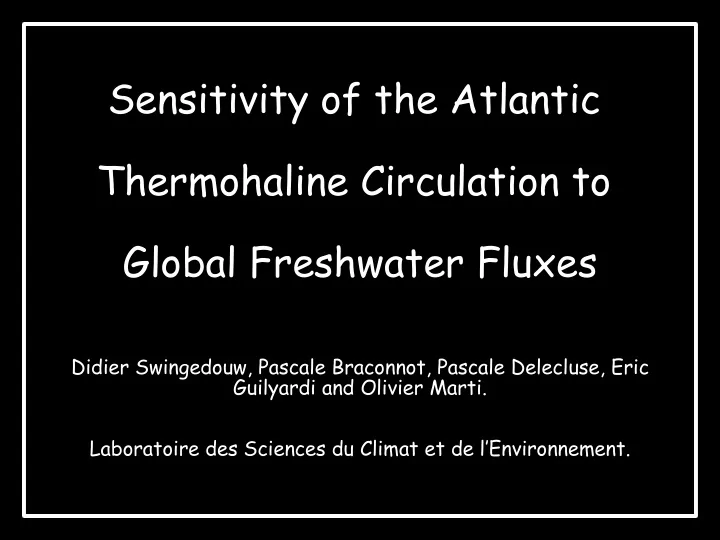

Sensitivity of the Atlantic Thermohaline Circulation to Global Freshwater Fluxes Didier Swingedouw, Pascale Braconnot, Pascale Delecluse, Eric Guilyardi and Olivier Marti. Laboratoire des Sciences du Climat et de l’Environnement.
IPCC THC Index (max meridional stream fonction) Background
IPCC THC Index (max meridional stream fonction) Background IPCC scénarii display a wide range of behaviors for the future of THC Differences are due to the intensified hydrological cycle, with ambivalent consequences Ex : Dixon (1999)
IPCC THC Index (max meridional stream fonction) Background IPCC scénarii display a wide range of behaviors for the future of THC Differences are due to the intensified hydrological cycle, with ambivalent consequences Ex : Dixon (1999) vs Latif (2000)
This study: Aims: Quantify the impact of global freshwater forcing on the THC, illustrating for each process: Time Scales and Magnitude Time Scales and Magnitude Tool: IPSL-CM4 coupled model
CTRL R0 Sensitivity experiments EP0 EPR0
SST : CTRL SSS : CTRL SST : CTRL-Levitus SSS : CTRL-Levitus
MLD : CTRL • Profile based climatology by de Boyer (2004) • No convection in the Labrador Sea in CTRL • Other sites are correct MLD : Climato
MLD : CTRL • Profile based climatology by de Boyer GIN (2004) • No convection in the Irminger Labrador Labrador Sea in CTRL • Other sites are correct MLD : Climato GIN • 3 boxes are defined for the remainder of Irminger Labrador the study
a) THC index THC response over R0 100 years EPR0 CTRL • EP0 decreases down to EP0 b) Difference with CTRL 3Sv • R0 increases up to 30 Sv • EPR0 is nearly the sum of EP0 and R0 over 60 years = Linearity on this time scale c) Sum of EP0 and R0 /EPR0 EP0+R0 EPR0 = EP0 + R0 EPR0 = EP0 + R0
Mixed layer for the last 50 years a) R0 Convection sites changes • Convection is enhanced in b) EP0 R0 • Convection vanishes in EP0 • Convection sites shift in EPR0: Labrador <-> Irminger Ssa Different impact Different impact c) EPR0 of Nsa and Ssa on of Nsa and Ssa on the stratification the stratification of the convection of the convection Nsa sites sites
a) R0 Mixed layer depth Stratification changes compared to CTRL in the b) EP0 Labrador Sea c) EPR0
a) R0 Mixed layer depth Stratification changes compared to 10 years CTRL in the b) EP0 Labrador Sea 30 years • Ssa decrease => positive impact in 10 years c) EPR0 • Nsa decrease => negative impact in 30 years • Labrador Sea mostly sensitive to Ssa and local forcing
Irminger GIN a) R0 a) R0 Mixed layer depth 10 ans 10 ans b) EP0 b) EP0 15 ans 20 ans c) EPR0 c) EPR0
Summary of the convection sites sensitivity Labrador Sea Irminger Sea GIN Seas Nsa + + + + + + (30 years) (15 years) (20 years) (30 years) (15 years) (20 years) - - - Ssa - - - (10 years) (10 years) (10 years) (10 years) (10 years) (10 years) - + / Global - + Global + : + : enhances convection - : - : limits convection / : Neutral impact, processes balance each other /
Conclusions Convection sites are sensitive to differents components of the hydrological cycle: Labrador / Irminger; (Wood 1999). 10 to 40 years time scales coherent with Vellinga (2002) Global freshwater forcing damps the THC, i.e. local freshwater forcing dominates over a time frame of 100 years i.e during transient response (Saenko, 2003) Model dependent results, but gives a framework for analysing THC spread due to changes in the freshwater forcing in IPCC scenarii.
Thank you MailTo: didier.swingedouw@cea.fr
IPCC THC Index (max meridional stream fonction) Background IPCC scénarii display a wide range of behaviors for the future of THC Differences are due to the intensified hydrological cycle, with ambivalent consequences
IPCC THC Index (max meridional stream fonction) Background IPCC scénarii display a wide range of behaviors for the future of THC Differences are due to the intensified hydrological cycle, with ambivalent consequences Ex : Latif (2000)
Recommend
More recommend